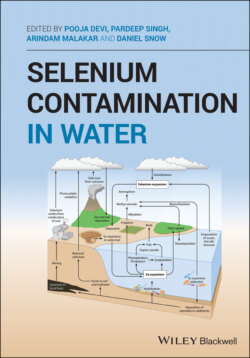Читать книгу Selenium Contamination in Water - Группа авторов - Страница 13
1.1.1 Contamination Status of Selenium
ОглавлениеThe authors have searched relevant literature related to the contamination status of selenium. Results indicate that selenium contamination is a global problem that affects a wide variety of human actions, from the most traditional farming methods to the most modern production processes. The USA, Canada, Republic of China, India, Japan, and Brazil are continuously making efforts to find out the technological solutions to remove the selenium.
In India, many areas are contaminated with selenium (Table 1.1). Punjab is the most affected region in Northwest India, with over 1000 ha of polluted fields. The main factors for the mobilization of Se and its bioavailability are alkaline soil pH, production of Se bioaccumulators, and inadequate industrial effluents/emissions treatment (Paikaray 2016). In the Majha belt of Punjab, which includes the Amritsar, Gurdaspur, and Tarn Taran districts, underground water is mainly contaminated with selenium and many other heavy metals (Virk 2018). Another belt which has groundwater quality‐affected habitations is the Doaba belt of Punjab, which includes the Jalandhar, Kapurthala, and Hoshiarpur districts (Virk 2019). As per Punjab Water Supply and Sanitation Department (PWSSD) data, selenium contamination of groundwater is greatest in the Jalandhar district in this belt. Selenium was detected in 105 habitations in Jalandhar, 30 in Kapurthala, and 19 in Nawanshahar. High‐level contamination of selenium was reported in the Malwa region of Ludhiana, with 90 habitations having higher than permissible limit of the metal with up to 0.140 mg/l content of selenium against the permissible limit of 0.01 mg/l. Another belt in Punjab, the “Malwa belt” of Ludhiana, Ferozepur, Roop Nagar, and Fatehgarh Sahib districts, also has selenium content in water sampled from tube wells (Virk 2019). The Doaba belt is the most selenium‐contaminated belt of Punjab. Also, in Punjab, surface soils are three to five times richer in selenium content compared to sub‐surface soils (Dhillon and Dhillon 1991).
Table 1.1 Selenium contamination status in Indian States.
| Author | Year | State | Districts | Contamination level |
|---|---|---|---|---|
| Virk | 2018 | Punjab (Majha Belt) | Tarn Taran | 0.010–0.076 |
| Gurdaspur | 0.010–0.094 | |||
| Amritsar | 0.010–0.039 | |||
| Virk | 2019 | Punjab (Doaba belt) | Jalandhar (Most contaminated) | 0.016–0.022 |
| Kapurthala | 0.01–0.082 | |||
| Hoshiarpur | 0.011–0.029 | |||
| Virk | 2019 | Punjab (Malwa belt) | Ludhiana | 0.016–0.14 |
| Roop Nagar | 0.01–0.20 | |||
| Ferozpur | 0.011–0.025 | |||
| Fatehgarh Sahib | 0.011–0.028 | |||
| Yadav et al. | 2005 | Rajasthan | Jaipur | Lower selenium level in Soil |
| Alwar | ||||
| Ghosh et al. | 2008 | Maharashtra | Mumbai | 0.08–1.10 mg/l |
| K. Chandrasekaran*, Manjusha Ranjit, and J. Arunachalam | 2009 | Punjab | 0.012–0.093 | |
| Sharma and Kumar | 2006 | Bihar | Bihar | |
| Kumar and Riyazuddin | 2011 | Tamilnadu | Chennai | 0.15–0.43 μg/l and 0.16–4.73 μg/l |
| Singh and Kumar | 1976 | Uttar Pradesh | Muzaffarnagar | |
| Vediya and Shrivastava | 2008 | Gujarat | Ahmadabad | 84.7–503.7 μg/l |
Overall, some areas are contaminated with selenium, others suffer from a deficiency of selenium. It has been inferred that deficiency‐related problems are common in arsenic (As)‐polluted sites like West Bengal (Das et al. 1995; Roychowdhury et al. 2003; Spallholz et al. 2004). In Western India, elevated soil selenium levels can be seen in Jaipur and Alwar, Rajasthan and selenium enrichment in brassica plants sown there has been shown (Yadav et al. 2005). In Maharashtra, up to 3 mg/kg and more than 1100 mg/l Se has been reported in soil and water, respectively, around Thane creek, Mumbai (Ghosh et al. 2008). In Central India, Jharkhand shows elevated levels of Se as it is a coal‐fired region (Finkelman and Stracher 2011) and Bihar shows elevated levels because of industrial effluents and emissions from the Barauni industrial area (Sharma and Kumar 2006). Lowlands and ponds have been contaminated with a high level (>10 mg/l) of Se due to disposal of untreated industrial wastes degrading the quality of underlying groundwater around Chennai City, Tami Nadu' (Kumar and Riyazuddin 2011). In Northern and North‐western India, Se content shows high variability. In Uttar Pradesh, in the Western part of Muzaffarnagar, there is a high selenium content in ground water, and different parts of Haryana show Se content ranging from 1 to 10.5 mg/kg (Singh and Kumar 1976). In Haryana, surface soils are mostly enriched with selenium other than areas receiving high rainfall like Ambala, Kurukshetra, Rohtak, and Sonipat.
